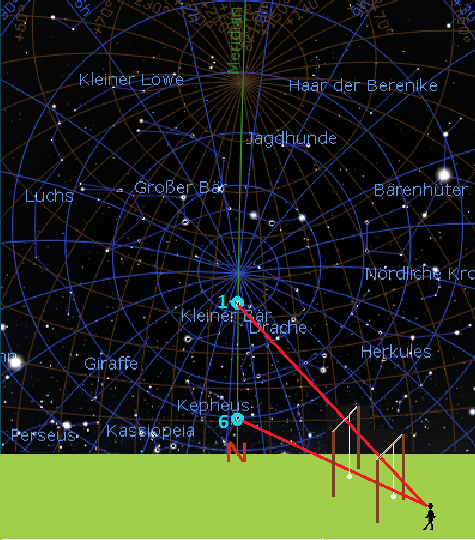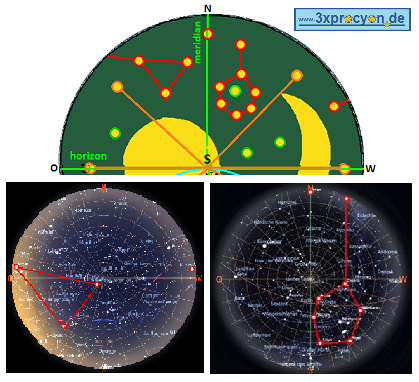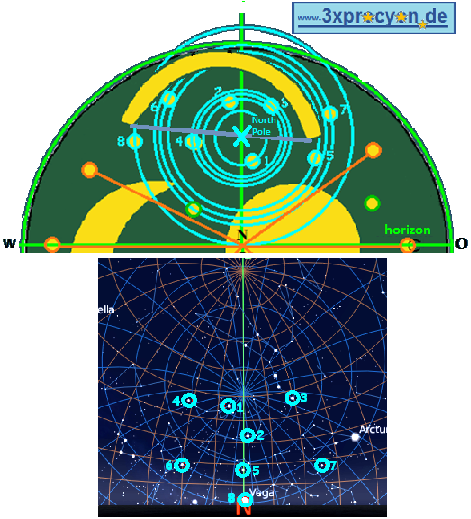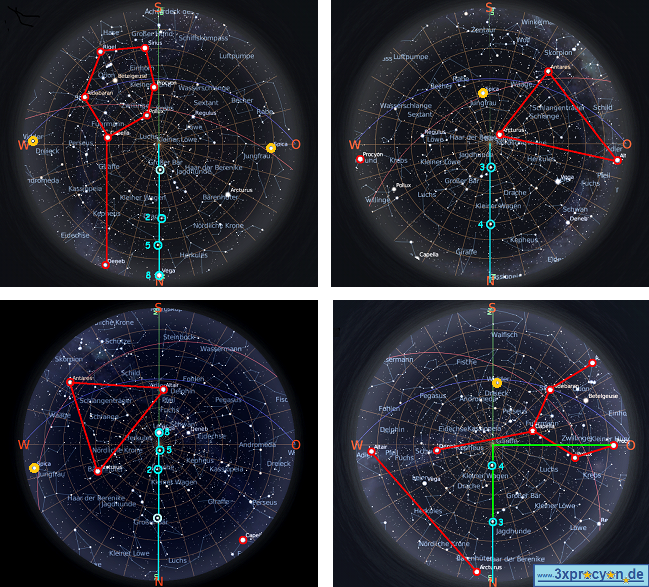 Two of the recognized eight circumpolar stars, Alderamin (10,8°) und Kocab (43,6°), were crossing formerly the meridian nearly at the same time, when they were positioned almost vertically on top of one another. They form an astral hand that could have shown the True North. Kate Spence, University of Cambridge, has proposed a surprising simple theory, which provides the key to the mysterious orientacion of the pyramids. … the Egyptians could have observed two stars, which were lying approximately in one line to the northern skypole, at that time.
Two of the recognized eight circumpolar stars, Alderamin (10,8°) und Kocab (43,6°), were crossing formerly the meridian nearly at the same time, when they were positioned almost vertically on top of one another. They form an astral hand that could have shown the True North. Kate Spence, University of Cambridge, has proposed a surprising simple theory, which provides the key to the mysterious orientacion of the pyramids. … the Egyptians could have observed two stars, which were lying approximately in one line to the northern skypole, at that time.
The North was where the extension of their connecting line hit the horizon vertically at night.
„The sky was the limit for the Pyramid builders
Dinah Ashman explains how modern astronomy may have put a new date on the building of the Great Pyramid at Giza.
A new theory of how exactly the ancient Egyptians oriented the pyramids according to the stars could put a date on the construction of the Great Pyramid at Giza near Cairo that is accurate within 5 years.
Builders probably got started between 2485 and 2475 BC, Kate Spence of the University of Cambridge, UK, proposes in Nature. Previous estimates have been accurate only to within 100 years. Spence’s idea could enable Egyptologists to refine their chronologies for all the reigns of the Old Kingdom — the middle of the third millennium BC.
„Spence has come up with an ingenious solution to a long-standing mystery,“ says Owen Gingerich of the Harvard-Smithsonian Center for Astrophysics, Cambridge, Massachusetts.
The new theory is inspired by the subtle deviations in the alignment of the eight pyramids at Giza from true north. The bases of the earliest-built pyramids point slightly east of north and those of the later-built ones, slightly west. The most precisely aligned pyramid is that of King Khufu or Cheops, also known as the Great Pyramid.
The pyramid builders, Spence suggests, used a pair of fairly bright stars, which in 2467 BC lay precisely along a straight line including the celestial north pole. Each star was about 10 degrees from the pole.
One is Kochab (ï-Ursae Minoris) in the bowl of the Little Dipper (Ursa Minor), the other Mizar (zeta-Ursae Majoris) in the middle of the handle of the Big Dipper (Ursa Major).
„In 2467 BC an Egyptian astronomer could wait while the heavens slowly pivoted around the unmarked pole until a plumb line exactly intersected both stars, one about 10° above the invisible pole and the other 10° below it,“ Gingerich explains. The sight line to the horizon point directly below the plumb line would then point straight to north.
Because of the Earth’s precession — the revolving axis of the Earth is unstable and rotates like a gyroscope with a period of 26,000 years — the celestial north pole was exactly aligned between Kochab and Mizar only in the year 2467 BC. Although given the precision of the measurements of the time, the ‚accurate‘ period was effectively a few years.
The orientation errors of earlier and later pyramids faithfully track the slow drift of Kochab and Mizar with respect to true north. Because the error in the Kochab-Mizar alignment can be readily calculated for any date, the error in each pyramid’s orientation reveals its construction date [1].“ [2]
______________________________
[1] Spence, Kate. Ancient Egyptian chronology and the astronomical orientation of pyramids. Nature 408, 320 – 324 .2000
[2] http://www.nature.com/news/2000/001116/full/news001116-10.html Dinah Ashman




